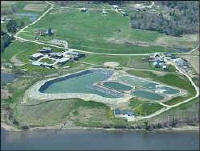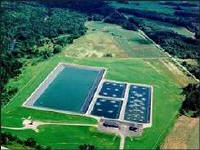|












2003
Maine Wastewater Salary Survey as conducted by the Maine Wastewater Control
Association

2003 Maine
Wastewater Rate Survey conducted by the Maine Rural
Water Association

Maine DEP Monthly
O & M Newsletter
Maine and WEF's
Operation Forum
Penobscot Watershed and Development of a TMDL
EPA Binational Toxics
Strategy
Maine Rural Water
Association
Maine Wastewater
Operator Certification
Guide
Maine Is Technology
Newsletter
Maine
Wastewater Control Association

Maine
Wastewater Engineering
Firms
| |
Lagoon Aeration - Coarse Bubble Static Tubes
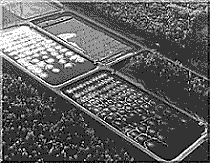

ll aeration systems try to dissolve
oxygen into the wastewater by creating bubbles that contain oxygen. As
the bubbles move through the water, air and oxygen will diffuse into the bulk
liquid by transferring across the bubbles surface. Course bubble static tubes
create bubbles ( photo of coarse bubble aeration pattern to the left ) by
pushing air through a series of baffles that break up the air flow into bubbles.
The bubbles are then ejected into the water at the top of the tubes. From this
point, they flow upward to the ponds surface. Along this critical path, the air
in the bubbles must diffuse into the ponds liquid. Once the bubbles reach the
ponds surface, it will be to late to transfer oxygen and all of the
remaining air will be lost to the atmosphere.
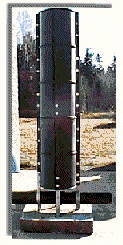
The static tube style aerator is shown to the right. The design of this system
is inherently flawed because the air is released into the water several feet off
the lagoon floor. This means that no aeration can occur in the lower half of the
lagoons depth. Sludge deposits that build up in this zone have no hope of ever
being re-suspended. They simply sit on the bottom and slowly decay under septic
conditions. This leads to an even greater depletion of oxygen from the overlying
lagoons liquid layer.
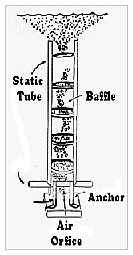
This design is further flawed in shallow lagoons given the fact that oxygen
transfer efficiency in a lagoon increases with every foot of depth. A lagoon
with ten feet of depth would be losing half of its potential oxygen transfer
efficiency by virtue of the fact that the diffusers sit so far off the floor.
With coarse bubble aeration, maximum oxygen transfer efficiency (OTE) of 0.75%
per foot of depth can be expected. This means that the OTE of a ten foot deep
lagoon would be 7.5% if the air was released at the lagoon's bottom. However,
only half of this efficiency, perhaps about 4% OTE, is realized since the air is
discharged half way up the pond's depth. Put another way, this same ten foot
deep lagoon could transfer twice as much air into the lagoon if the coarse
bubble diffusers were closer to the pond's floor. As will be discussed further,
this efficiency could be further increased by creating fine bubbles instead of
coarse bubbles.
For more information on
the use of coarse bubble aeration one may consult the Water Pollution Control
Federation's Manual of Practice FD - 13 entitled "Aeration".
Fine Bubble Aeration

|
